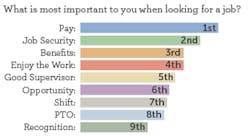Each year since 2007, ProLogistix has conducted a Warehouse Employee Opinion Survey. This year over 5,000 hourly employees in the logistics sector—working for ProLogistix, for our clients, or actively in a job search—completed the survey. The group represents a wide range of skill sets and geography.
In our first article in this series, we outlined the reasons for undertaking this project, and the insight into workforce issues we seek for our company and our clients.
In this article, we focus on the number one subject of importance to hourly warehouse employees according to the survey: pay rate… or, more specifically, fair, competitive pay. The bar graph below summarizes the answer to this question:
These results are not a surprise to us. Pay has ranked #1 every year we have conducted the survey. Our sister company, ResourceMFG, reports very similar results from the manufacturing workforce: Pay ranks #1. Our other sister company, ProDrivers, surveyed the Class A truck driver workforce in late 2015: Again, pay ranks first. Across the supply chain, the answer is the same.
For some, this finding may not be especially intuitive. Certainly, job security (ranked #2), good benefits (#3), and other factors are important to today’s employees; long-term workforce retention and engagement is, of course, multi-faceted.
However, on further study, the importance of pay becomes self-evident. Many warehouse employees have entry-level skills, or have experience in more skilled positions (for example, picker/packers with RFID capability or forklift operators). Depending on the market and position, pay rates for most of these jobs can range from about $10.00 per hour (or less) up to $15.00.
For many, these pay rates are challenging, to say the least. These workers live from paycheck to paycheck, and often have dependents. For them, ‘Job One’ is getting as much money in the paycheck as possible up front to make ends meet.
To that end, they often have to make hard choices. Some examples:
• Next to layoffs, the #1 reason those surveyed left their last job? “Found a new job that paid more money.”
• 54.1% would move to a less desirable shift for as little as $1.00 more per hour (often less), according to the survey results.
• 34.5% of those surveyed do not have health insurance.
And external factors compound the issue. For example, according to the survey, over the past two years, employees’ average pay rates have increased a scant 1.2%, despite unemployment rates consistently decreasing over that same time period.
So, more often than not, our advice to our warehousing clients is this: Let’s set the wage rate as fairly and competitively as possible from day one. It is the most important factor to this vital part of their operation: the workforce.
In the next article in this series, we will cover what insights the survey sheds on shift differentials, turnover, retention and other topics.
Keith Wisner is vice president, workforce & supply chain analytics, with ProLogistix, an EmployBridge Company.




